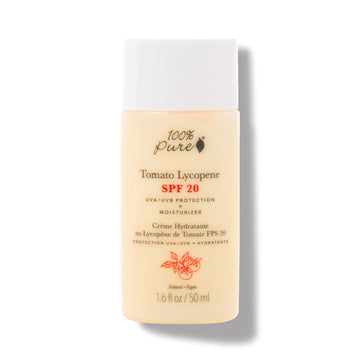Laying out what we love about sea buckthorn skin care
Written by: 100% PURE®
Could a little goldish berry be worth its weight in gold? It could if it’s sea buckthorn oil, dubbed in skin care as ‘liquid gold’ for your face. With its impressive A-list of antioxidants, it’s no wonder that sea buckthorn skin care could be the golden ticket to radiant, youthful skin. Ready to explore its benefits?
Read on as we delve into the interesting origins of the sea buckthorn plant. We’ll spill the berries (and seeds) on the 24k beauty benefits of this relative newcomer to the skin care elite. We know you’ll feel berry inspired to incorporate sea buckthorn skin care into your beauty routine. And here’s why!
Great question! As part of its name suggests, sea buckthorn is a thorny plant. But it’s not derived from underwater like another beloved skin care sea ingredient, algae.
It’s been known, however, to grow around some shorelines; say, for example, in Dublin. But most sea buckthorn (a.k.a. seaberry or sallowthorn) exists in higher altitudes and mountainous regions of northern Europe, China, Mongolia, Russia, and Canada.
Though the skin benefits of this super fruit have more recently gone mainstream, the medicinal uses of the sea buckthorn plant (Hippophae rhamnoides) have been around for centuries. The word Hippophae has been derived from the Latin words ‘Hippo’ meaning horse and ‘Phaos’ which means ‘shine’ – all stemming from ancient Greeks who fed their horses this plant.
Many cultures in Eurasia have used sea buckthorn for its medicinal and nutritional benefits for centuries. These various cultures have used its leaves, flowers, fruits, and bark in many products for various health issues. For instance, since its leaves are excellent sources of antioxidants and have anti-inflammatory powers, they were brewed and enjoyed as a healing tonic.
FUN FACT: There are seven species of sea buckthorn, but Hippophae Rhamnoides ‘L’ is the most widely used across the world.

These berries may be tiny, but they pack mighty sea buckthorn skin care benefits. Its claim to beauty fame comes from the two types of oil derived from the berries and seeds found inside them. The fruit oil comes from the fleshy pulp of the berry and is dark orange to red. The small black seeds are the source of the seed oil, which is yellow or pale orange.
Why is sea buckthorn skin care considered the latest fountain of youth? This super beauty ingredient has a plethora of rejuvenating and healing benefits for the skin – including one that sets it apart from all the rest! Stay with us for that. It also has an impressive nutritional profile that includes:
More than 190 nutrients as well as phytonutrients – natural chemicals produced by the plant that have antioxidant and anti-inflammatory properties
A variety of essential fatty acids and antioxidants such as vitamins A, C, and E, as well as anthocyanins – an antioxidant that helps fight free radicals
High amounts of beta carotene, a precursor of vitamin A for the maintenance of normal skin
More vitamin E (d-alpha-Tocopherol) than any other plant-based oil known now
Get this, sea buckthorn has more vitamin C than an orange – 10 times more – and three times more vitamin A than carrots. It’s also the only known plant source on the planet that contains omegas 3, 6, 9, and 7!
These are even more reasons to love sea buckthorn skin care. And this vitamin-packed superstar is one of the key ingredients of our mega-nourishing Super Fruit Cream, Super Fruit Balm, and Super Fruit Facial Oil!

Sea buckthorn berry and seed oil have many similarities, making them a dynamic sea buckthorn skin care anti-aging duo. But what’s berry exciting is although the fruit and seed oil come from the same plant, they have different nutritional makeups. What’s more, these oils look, taste, and smell different. Sounds like the sea buckthorn plant has some fraternal twins!
What’s most significant about this pair is the difference between the fatty acid makeup of the seed oil versus the berry oil. The major fatty acids contained in the seed oil are omegas 3 and 6, while the fruit oil contains more monounsaturated fatty acids and omega 7. Here’s a little visual of how they differ and what they help to do.
|
Seed Oil Skin brightening Reduces inflammation (great for acne) Perfect ratio of omega 6 and 3 (pair well as age fighters) |
Berry Oil Calms red, inflamed skin (like eczema) Combats dryness (great for dry skin types) Repairs and nurtures skin damage (helps with scars) |
Besides providing amazing beauty benefits, sea buckthorn oil has amazing anti-aging properties and works wonders for moisturizing, healing, and protecting skin. Due to its high omega 7 content, it’s great for promoting skin elasticity. It stimulates the regenerative processes in the epidermis layer of the skin, making sea buckthorn oil a beneficial ingredient for our Tomato Lycopene SPF 20 Moisturizer and Multi-Vitamin + Antioxidants PM Facial Oil.
Now that we’ve covered the many skin-loving benefits of sea buckthorn oil, it’s no wonder sea buckthorn skin care is big in the beauty realm. Could it be the golden ticket for glowing, youthful skin? You’ll have to let us know!
- Tags: January-2022, Skin Care, skincare
We carefully hand-select products based on strict purity standards, and only recommend products we feel meet this criteria. 100% PURE™ may earn a small commission for products purchased through affiliate links.
The information in this article is for educational use, and not intended to substitute professional medical advice, diagnosis, or treatment and should not be used as such.








